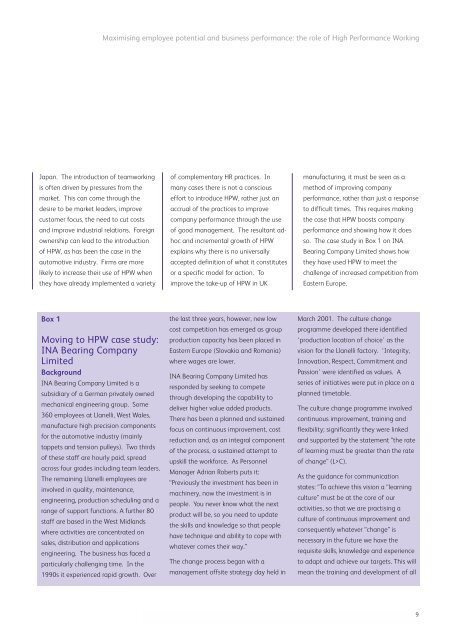About EEF - CIPD
About EEF - CIPD
About EEF - CIPD
You also want an ePaper? Increase the reach of your titles
YUMPU automatically turns print PDFs into web optimized ePapers that Google loves.
Maximising employee potential and business performance: the role of High Performance WorkingJapan. The introduction of teamworkingis often driven by pressures from themarket. This can come through thedesire to be market leaders, improvecustomer focus, the need to cut costsand improve industrial relations. Foreignownership can lead to the introductionof HPW, as has been the case in theautomotive industry. Firms are morelikely to increase their use of HPW whenthey have already implemented a varietyof complementary HR practices. Inmany cases there is not a consciouseffort to introduce HPW, rather just anaccrual of the practices to improvecompany performance through the useof good management. The resultant adhocand incremental growth of HPWexplains why there is no universallyaccepted definition of what it constitutesor a specific model for action. Toimprove the take-up of HPW in UKmanufacturing, it must be seen as amethod of improving companyperformance, rather than just a responseto difficult times. This requires makingthe case that HPW boosts companyperformance and showing how it doesso. The case study in Box 1 on INABearing Company Limited shows howthey have used HPW to meet thechallenge of increased competition fromEastern Europe.Box 1Moving to HPW case study:INA Bearing CompanyLimitedBackgroundINA Bearing Company Limited is asubsidiary of a German privately ownedmechanical engineering group. Some360 employees at Llanelli, West Wales,manufacture high precision componentsfor the automotive industry (mainlytappets and tension pulleys). Two thirdsof these staff are hourly paid, spreadacross four grades including team leaders.The remaining Llanelli employees areinvolved in quality, maintenance,engineering, production scheduling and arange of support functions. A further 80staff are based in the West Midlandswhere activities are concentrated onsales, distribution and applicationsengineering. The business has faced aparticularly challenging time. In the1990s it experienced rapid growth. Overthe last three years, however, new lowcost competition has emerged as groupproduction capacity has been placed inEastern Europe (Slovakia and Romania)where wages are lower.INA Bearing Company Limited hasresponded by seeking to competethrough developing the capability todeliver higher value added products.There has been a planned and sustainedfocus on continuous improvement, costreduction and, as an integral componentof the process, a sustained attempt toupskill the workforce. As PersonnelManager Adrian Roberts puts it:“Previously the investment has been inmachinery, now the investment is inpeople. You never know what the nextproduct will be, so you need to updatethe skills and knowledge so that peoplehave technique and ability to cope withwhatever comes their way.”The change process began with amanagement offsite strategy day held inMarch 2001. The culture changeprogramme developed there identified‘production location of choice’ as thevision for the Llanelli factory. ‘Integrity,Innovation, Respect, Commitment andPassion’ were identified as values. Aseries of initiatives were put in place on aplanned timetable.The culture change programme involvedcontinuous improvement, training andflexibility; significantly they were linkedand supported by the statement “the rateof learning must be greater than the rateof change” (L>C).As the guidance for communicationstates: “To achieve this vision a “learningculture” must be at the core of ouractivities, so that we are practising aculture of continuous improvement andconsequently whatever “change” isnecessary in the future we have therequisite skills, knowledge and experienceto adapt and achieve our targets. This willmean the training and development of all9
















